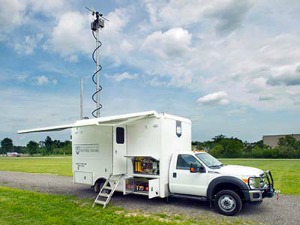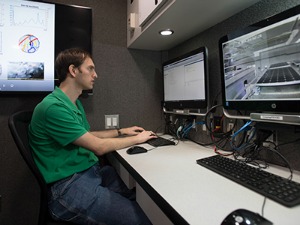Field Research Vehicles (FRVs)
A Pair of Vehicles to Support Research in Wireless Communications
The University of Notre Dame’s pair of Field Research Vehicles (FRVs) are 9-ton vehicles equipped to support research and experimentation in wireless communications, radar, intelligence/surveillance/reconnaissance (ISR), electronic warfare (EW), and active/passive sensing. The vehicles were obtained with a DURIP grant from the Navy. The customized vehicles, manufactured by MBF Industries, were delivered to the University of Notre Dame in January 2015 and were operational in July 2015. The vehicles feature telescoping (and locking) 42’ masts with a rotor mounted at the top and locations for antennas and RF equipment. Connectivity from the masthead to the equipment bay in the vehicle is achieved via a Nycoil conduit packed with 36 optical fibers, conductors, RF cabling, and Ethernet. Typically, the vehicles are configured with transceivers based on 2×2, 2×4, and 4×4 coherent MIMO architectures with RF equipment mounted on top of the mast and with optical fiber connectivity to a server in the FRV, enabling remote programming and control of the devices, and to transfer sampled complex baseband signals from the receiver at the masthead to the server in the equipment bay. Current RF capabilities extend up to 6 GHz but will be increased to 20 GHz in Q4 of 2017.
Various Antennas
Various antennas in the 470 MHz, 915 MHz, 2.4 GHz, 5GHz can be mounted either on the masthead or on the rails at the top of the vehicle. Two wideband dual-pol open-boundary quad-ridged horn antennas are also available covering the entire band between 400 MHz to 6 GHz. Power for equipment can be obtained from various FRV-based sources, including an onboard 12 kW generator, an array of rechargeable 12V batteries coupled to an inverter, rooftop solar panels (1 kW), and a wind turbine (600W). AC, 12V, and 28V and Ethernet lines are distributed throughout the interior of the FRVs and are also available at the top of the mast in the FRV cab.


Internal Workstations
The trucks each have four workstations and a 50” monitor. Azimuth/Elevation of the antenna rotor at the top of the masthead may be remotely controlled from within the FRV bay. Typical active displays in the bay include imagery from a camera mounted on the masthead, RF signal data products that are processed by the receiver system, and graphical user interfaces used to control equipment.
Continuous Improvement
The vehicles continue to expand in capability and will have provision to host a new 8×8 $1M coherent MIMO transceiver system that was recently acquired through a 2016 DURIP grant.
Projects
The FRVs are used on multiple projects including
Radar Applications
Multiple projects funded by the Navy are in progress to develop and evaluate MIMO-based dual-polarization radar implementations and signal processing techniques.
ISR Applications
The vehicles are anticipated to be used in research funded by the Office of Naval Research to evaluate methods for signal classification of both fixed and mobile signals
Novel Communications Approaches
In research funded by the Office of Naval Research, Notre Dame is using the FRVs to support pioneering work associated with coherent MIMO communications techniques.
Atmospheric Research
Materhorn – The FRVs were used to support the development and testing of techniques for remote sensing of soil moisture changes. The effort was a small part of a much larger MURI effort funded by multiple sources, including the Navy, Army, and others.
Casper – Testing has been conducted at Duck, North Carolina to evaluate passive measurement approaches to detect the formation of maritime boundary layers. This effort is a small part of a much larger MURI program being funded by the Navy.
Principle Investigator
The PI for the FRVs is Tom Pratt of the Department of Electrical Engineering. His research group includes Rob Kossler (Senior Research Engineer), Eric Jesse (Research Engineer), Ben Strycker (Postdoctoral Researcher), and several Ph.D. students.

